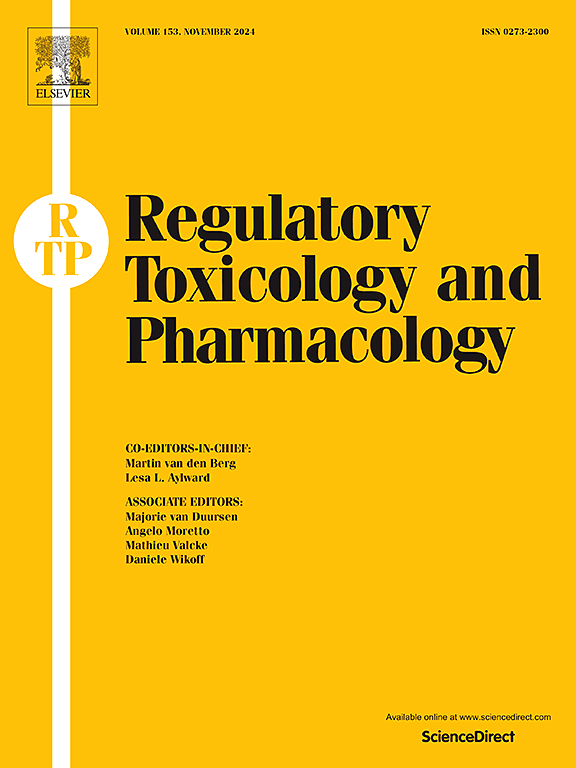Use of alternatives to animal testing for Environmental Safety Assessment (ESA): Report from the 2023 EPAA partners’ forum
IF 3
4区 医学
Q1 MEDICINE, LEGAL
引用次数: 0
Abstract
Environmental Safety Assessments (ESA) are mandatory for several regulatory purposes and are an important component of stewardship/sustainability initiatives. Fish testing is used for assessing chemical toxicity and bioaccumulation potential; amphibians are included in some jurisdictions and their use is increasing to assess endocrine disruption. Alternative methods are becoming more available, covering the principles of the 3Rs (i.e., replacing, reducing and refining animal tests), but their regulatory incorporation is still limited. A cross-sector review by the European Partnership for Alternative Approaches to Animal Testing (EPAA), discussed the status and priorities for accelerating the adoption of non-animal approaches in ESA. The lack of an internationally agreed definition for “animal testing” was recognized as a challenge. For example, testing with vertebrate embryos up to specific developmental stages is a suitable refinement alternative only in some jurisdictions. Invertebrate testing offers refinement alternatives to develop tiered approaches using vertebrate testing as a last resort. Aquatic ESA was identified as a common need by all sectors and regulatory areas, while terrestrial ESA is particularly relevant for agrochemicals. The standardization and validation of some alternative methods as OECD test guidelines (TGs) for fish acute toxicity and fish bioaccumulation have not yet triggered the expected replacement in regulatory settings. Priority actions in these areas are needed to generate confidence in the regulatory use of the available OECD TGs designed as alternatives, including the identification of applicability domains and guidance/decision-trees for integrating different lines of evidence. Case studies under the OECD Integrated Approaches to Testing and Assessment (IATA) program could facilitate further global regulatory uptake. Replacement of fish chronic toxicity testing is more complex and less advanced. A dual approach was suggested, in the short-term, exploring lines of evidence that, alone or in combination, could identify when further fish testing is not needed. The second phase should focus on the application of the 3Rs in those cases where chronic information is needed. Another area of increasing interest is endocrine disruption. It represents a challenge but also an opportunity for implementing mechanistic non-animal methods, in addition to integrate human and ESA. This requires a step-by-step approach with continuous dialogue to ensure that technical developments will address regulatory needs. The review also agreed that the long-term aspiration is a new ESA paradigm, mapping the protection goals and providing connectivity between the chemical legislation and environmental protection policies.
使用动物试验替代环境安全评估(ESA):来自2023年epa合作伙伴论坛的报告。
出于若干监管目的,环境安全评估(ESA)是强制性的,是管理/可持续发展倡议的重要组成部分。鱼类试验用于评估化学毒性和生物蓄积潜力;在一些司法管辖区,两栖动物也被包括在内,而且越来越多地使用两栖动物来评估内分泌紊乱。替代方法越来越多,涵盖了3r的原则(即替代、减少和改进动物试验),但它们在监管方面的纳入仍然有限。欧洲动物试验替代方法伙伴关系(EPAA)进行了一项跨部门审查,讨论了在ESA加速采用非动物方法的现状和优先事项。缺乏国际商定的“动物试验”定义被认为是一项挑战。例如,对脊椎动物胚胎进行特定发育阶段的测试仅在某些司法管辖区是一种合适的改进选择。无脊椎动物测试作为最后的手段,为开发分层方法提供了改进的选择。所有部门和管理领域都认为水生欧空局是一项共同需要,而陆地欧空局则与农用化学品特别相关。作为经合组织鱼类急性毒性和鱼类生物蓄积测试指南(TGs)的一些替代方法的标准化和验证尚未在监管环境中引发预期的替代。需要在这些领域采取优先行动,以建立对作为备选方案的现有经合组织技术指标的监管使用的信心,包括确定适用领域和整合不同证据线的指导/决策树。经合组织测试和评估综合方法(IATA)计划下的案例研究可以促进进一步的全球监管。替代鱼类的慢性毒性测试更复杂,也不那么先进。有人建议在短期内采取一种双重方法,探索各种证据,单独或结合起来,可以确定何时不需要进一步的鱼类试验。第二阶段应侧重于在需要长期信息的情况下应用3r。人们越来越感兴趣的另一个领域是内分泌紊乱。除了整合人类和欧空局之外,它代表了实施机械非动物方法的挑战,但也是一个机会。这需要一种循序渐进的方法,通过持续的对话来确保技术发展将满足监管需求。审查还同意,长期愿望是建立一个新的欧空局范例,确定保护目标,并在化学品立法和环境保护政策之间建立联系。
本文章由计算机程序翻译,如有差异,请以英文原文为准。
求助全文
约1分钟内获得全文
求助全文
来源期刊
CiteScore
6.70
自引率
8.80%
发文量
147
审稿时长
58 days
期刊介绍:
Regulatory Toxicology and Pharmacology publishes peer reviewed articles that involve the generation, evaluation, and interpretation of experimental animal and human data that are of direct importance and relevance for regulatory authorities with respect to toxicological and pharmacological regulations in society. All peer-reviewed articles that are published should be devoted to improve the protection of human health and environment. Reviews and discussions are welcomed that address legal and/or regulatory decisions with respect to risk assessment and management of toxicological and pharmacological compounds on a scientific basis. It addresses an international readership of scientists, risk assessors and managers, and other professionals active in the field of human and environmental health.
Types of peer-reviewed articles published:
-Original research articles of relevance for regulatory aspects covering aspects including, but not limited to:
1.Factors influencing human sensitivity
2.Exposure science related to risk assessment
3.Alternative toxicological test methods
4.Frameworks for evaluation and integration of data in regulatory evaluations
5.Harmonization across regulatory agencies
6.Read-across methods and evaluations
-Contemporary Reviews on policy related Research issues
-Letters to the Editor
-Guest Editorials (by Invitation)

 求助内容:
求助内容: 应助结果提醒方式:
应助结果提醒方式:


